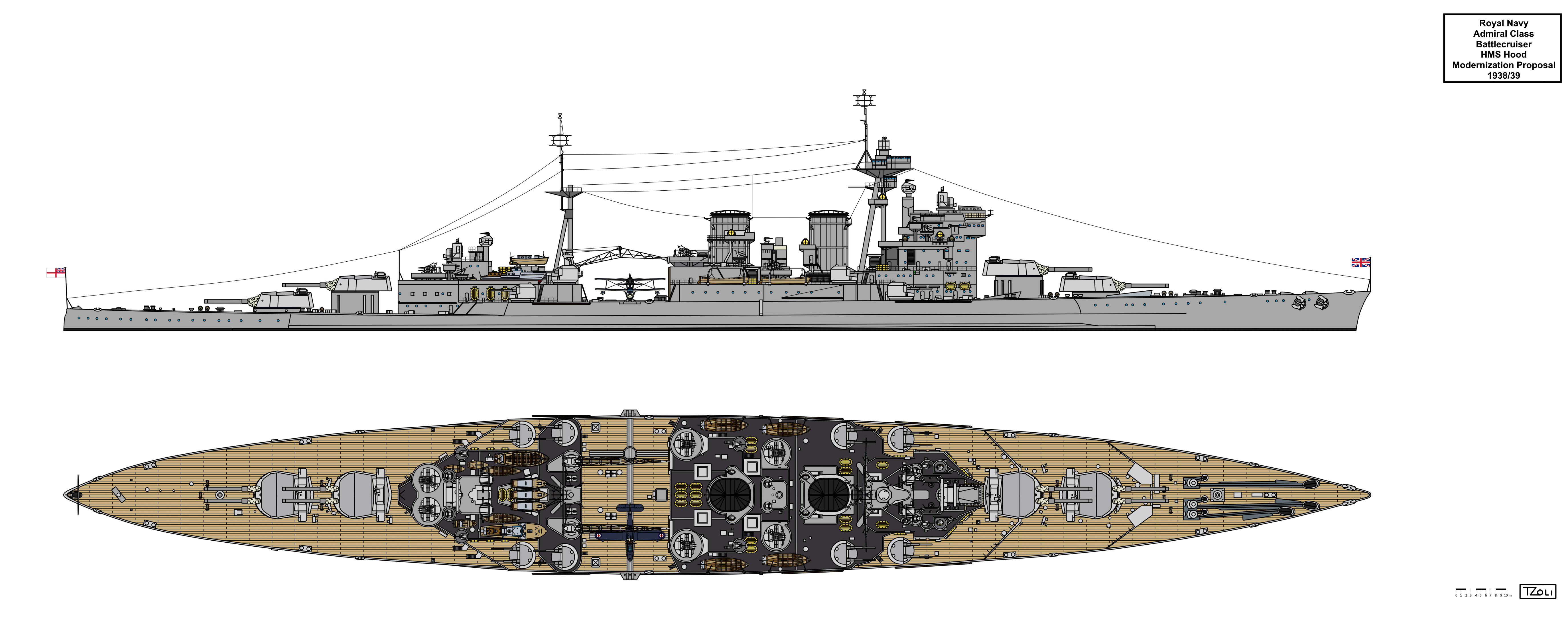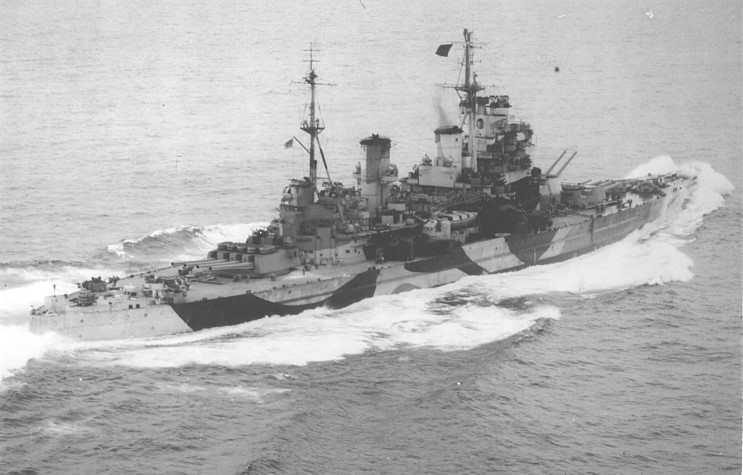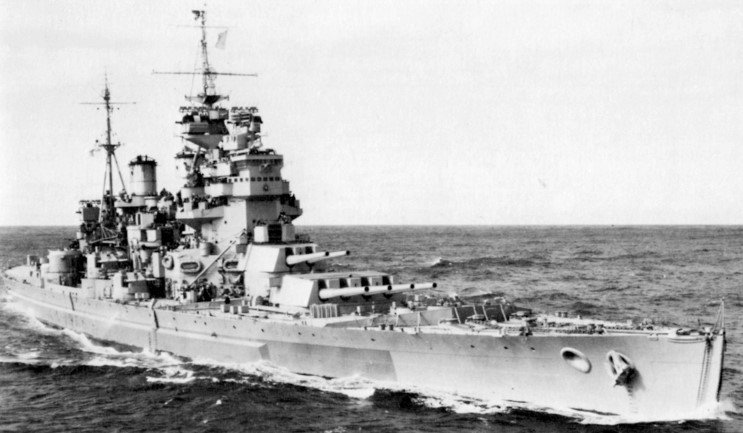- Joined
- 1 February 2011
- Messages
- 2,615
- Reaction score
- 2,591
I've not long ago finished my drawings about the development and various preliminary studies of the Admiral or Hood class Battlecruisers, and now I share it here as well.
So let's start with the six preliminary proposals:
Official documents:
i.imgur.com/zhb2wxR.jpg
i.imgur.com/fIjE20R.jpg
i.imgur.com/n1Kwcwp.jpg
i.imgur.com/hje3Yhb.jpg
Battlecruiser Design 1916 Scheme 1

The Origins of the Admiral class Battlecruisers or as more commonly known HMS Hood could be traced back to the 1915 when Admiral of the Fleet John Rushworth Jellicoe required more 15" armed warships as soon as possible, hence DNC started working on an improved Queen Elizabeth type with 4x2 15" and 12x1 5" armament together with 4x1 21" underwater torpedo tubes. A number of designs were born: A,B,C1,C2 and D. All of them were forwarded to Jellicoe, but he discarded them as he did not wanted new battleships at all saying the overall superiority of the type in the hands of the Royal Navy.
He considered the numbers of battlecruisers too small compared to the Germans, who were already building at least three very fast and powerful battlecruisers: SMS Hindenburg, SMS Mackensen and SMS Prinz Eitel Friedrich, in addition to SMS Lützow.
He thought had no use for DNC’s fusion aka fastbattleships, he wanted true slow battleships or 30-knot battlecruisers. His view was partly based on disappointment with the Queen Elizabeths, whose limited speed made it ‘questionable whether they
will be able to get to the head of the line on deployment without blanketing the battle line’. Given their light protection, none of Fisher’s new ships (HMS Renown and Repulse) could fight German battlecruisers. But there were no battlecruiser designs ready at that time so DNC had to use designs privately created by Sir Eustace Henry William Tennyson d'Eyncourt, lead naval architect of the RN by the request of Admiral John Arbuthnot Fisher, Many of these designs featured the new 18" gun of Fisher which the RN had no interest in! This might be a reason why the Admiral class in her original design having soo larger hull than a 4 turreted Renown despite the same armour and speed! They might had designed to carry something much heavier than the 15"/42 BL Mark I cannons of the time...
Design I was the first in the series proposed for Jellicoe for a new construction battlecruiser. With it's layout of both primary and secondary armament as well as in number it is very similar to the HMS Hood as ordered although the number of 5,5" guns only counted to 12 and the AA guns were the standard early WW1 selection of two single 3" ones. What is most striking was the size of the design: 269,75m overall some 7m longer than Hood despite the lower engine output and thus slower speed. The reason behind this are the choice of Babcock & Wilcox type large tube boilers, identical to that of the Renown class battlecruiser and which driven up both hull size and tonnage. Based on their power output, around 42 such boilers would had been required for the desired 120.000shp which is quite a considerable number to the final design's 144.000shp and 24 Yarrow Small Tube boilers!
Another striking difference was the lack of mainmast aft which allowed an easier opportunity of the enemy (according to Jellicoe) to determine the ship's direction. hence only the crane's smaller mast I put there.
The design had the following characteristics:
Dimensions: 254,51 (pp) x 266,82 (wl) x 269,75 (oa) x 31,7 x 7,92 meters
Displacement: 39.000tons (standard)
Armour: 203mm belt at 10°incline, 25mm over Machinery, 38mm over Magazines deck, 38-38mm slopes.
Engines: 120.000shp Parsons Steam Turbines, 4 shafts
Range: 14.200km at 30km/h (7.600nm at 16knots)
Speed: 56km/h (30knots)
Armaments:
4x2 15"/42 (381mm/42) BL Mark I Cannons,
12x1 5,5"/50 (140mm/50) BL Mark I Guns,
2x1 3"/42 (76mm/45) QF HA Mark I AA Guns,
2x1 53cm Underwater Torpedo Tubes
Battlecruiser Design 1916 Scheme 2

Design II was the second in the series proposed for Jellicoe for a new construction battlecruiser. It is essentially the same as Scheme 1 but using Yarrow small tube boilers instead of Babcock & Wilcox type large tube boilers for the same 120.000shp. As you can see, development in engine technology allowed the designers to produce ships with smaller machinery space yet more power output! I calculate that around 20 Yarrow Small Tube boilers were required for the desired power output. This resulted in a much shorter proposal of roughly 14m shorter hull together with the weight saving in armour to protect the hull with a considerable 3.500tons sving in displacement! Otherwise like armament layout armour speed etc it is identical to that of Scheme 1.
The design had the following characteristics:
Dimensions: 240,79 (pp) x 253,1 (wl) x 256,03 (oa) x 31,7 x 7,92 meters
Displacement: 35.500tons (standard)
Armour: 203mm belt at 10°incline, 25mm over Machinery, 38mm over Magazines deck, 38-38mm slopes.
Engines: 120.000shp Parsons Steam Turbines, 4 shafts
Range: 14.200km at 30km/h (7.600nm at 16knots)
Speed: 56km/h (30knots)
Armaments:
4x2 15"/42 (381mm/42) BL Mark I Cannons,
12x1 5,5"/50 (140mm/50) BL Mark I Guns,
2x1 3"/42 (76mm/45) QF HA Mark I AA Guns,
2x1 53cm Underwater Torpedo Tubes
Battlecruiser Design 1916 Scheme 3

Design III was the third in the series proposed for Jellicoe for a new construction battlecruiser. While the previous proposals were 30knot versions, here d'Eyncourt calculated that by lengthened the hull and increasing the engine power to 160.000shp a higher 32knot or 59km maximum speed could be reached. Other aspects was identical to the other two previous proposals. Among the 6 designs the Admiralty chose this, Scheme 3 for further development which eventually became the Admiral class Battlecruiser HMS Hood.
The design had the following characteristics:
Dimensions: 246,9 (pp) x 259,2 (wl) x 262,13 (oa) x 31,7 x 7,62 meters
Displacement: 36.300tons (standard)
Armour: 203mm belt at 10°incline, 25mm over Machinery, 38mm over Magazines deck, 38-38mm slopes.
Engines: 160.000shp Parsons Steam Turbines, 4 shafts
Range: 14.200km at 30km/h (7.600nm at 16knots)
Speed: 59km/h (32knots)
Armaments:
4x2 15"/42 (381mm/42) BL Mark I Cannons,
12x1 5,5"/50 (140mm/50) BL Mark I Guns,
2x1 3"/42 (76mm/45) QF HA Mark I AA Guns,
2x1 53cm Underwater Torpedo Tubes
Battlecruiser Design 1916 Scheme 4

Design IV was the fourth in the series proposed for Jellicoe for a new construction battlecruiser. But this is the first true capital ship designed in the RN to carry a meaningful number of 18" weapons! You can think of it as a mix of Hood, Courageous/Glorious and Furious. The use of only two twin turrets meant that the protective citadel and thus the entire hull could be shortened drastically saving costs. The engine power remained the same as of Scheme 2 and I've used a single thick funnel to further differentiate this proposal from the rest.
The design had the following characteristics:
Dimensions: 216,41 (pp) x 227,8 (wl) x 230,73 (oa) x 31,7 x 7,62 meters
Displacement: 32.500tons (standard)
Armour: 203mm belt at 10°incline, 25mm over Machinery, 38mm over Magazines deck, 38-38mm slopes.
Engines: 120.000shp Parsons Steam Turbines, 4 shafts
Range: 14.200km at 30km/h (7.600nm at 16knots)
Speed: 56km/h (30knots)
Armaments:
2x2 18"/40 (457mm/40) BL Mark I Cannons,
12x1 5,5"/50 (140mm/50) BL Mark I Guns,
2x1 3"/42 (76mm/45) QF HA Mark I AA Guns,
2x1 53cm Underwater Torpedo Tubes
Battlecruiser Design 1916 Scheme 5

Design V was the fifth in the series proposed for Jellicoe for a new construction battlecruiser. This design is much better looking warship both armament and ship size wise. The hull is just a few meters shorter to that of design 2 and uses the same powerplant but the larger turrets meant that even with 3 turrets the hull got only 3meters shorter. If the Admiralty would had been considered the 18" gun this ship would be a likely candidate for construction having some 800tons lighter than Design 3 which was chosen for further development. You can see this proposal if you will a Hoodified Renown with 18" turrets.
The design had the following characteristics:
Dimensions: 237,74 (pp) x 250,05 (wl) x 253 (oa) x 31,7 x 7,62 meters
Displacement: 35.500tons (standard)
Armour: 203mm belt at 10°incline, 25mm over Machinery, 38mm over Magazines deck, 38-38mm slopes.
Engines: 120.000shp Parsons Steam Turbines, 4 shafts
Range: 14.200km at 30km/h (7.600nm at 16knots)
Speed: 56km/h (30knots)
Armaments:
3x2 18"/40 (457mm/40) BL Mark I Cannons,
12x1 5,5"/50 (140mm/50) BL Mark I Guns,
2x1 3"/42 (76mm/45) QF HA Mark I AA Guns,
2x1 53cm Underwater Torpedo Tubes
Battlecruiser Design 1916 Scheme 6

Design VI was the sixth and last in the series proposed for Jellicoe for a new construction battlecruiser. This design despite not the largest proposal but both the heaviest and most heavily armed version with 8 18" cannons mounted in 4 twin turrets. You can sort of call it the Super Hood despite it is a design preceding it because the 18" cannons would certainly hit quite a punch in the enemy battleline. This was the last of the Admiral class preliminary studies and the last capital ship design to my knowledge to feature 18" weaponry till the 1920's with the N3/G3 design process started and all the experiences of the Great War got processed and thought over.
But this was not the end of the big guns in the Royal Navy, while Admiral Fisher still had influence he proposed a Super Furious with single 20" cannons as well as some of the HMS Incomparable studies which also featured this fearsome weapon!
The design had the following characteristics:
Dimensions: 252,98 (pp) x 265,29 (wl) x 268,22 (oa) x 31,7 x 7,92 meters
Displacement: 39.500tons (standard)
Armour: 203mm belt at 10°incline, 25mm over Machinery, 38mm over Magazines deck, 38-38mm slopes.
Engines: 120.000shp Parsons Steam Turbines, 4 shafts
Range: 14.200km at 30km/h (7.600nm at 16knots)
Speed: 56km/h (30knots)
Armaments:
4x2 18"/40 (457mm/40) BL Mark I Cannons,
12x1 5,5"/50 (140mm/50) BL Mark I Guns,
2x1 3"/42 (76mm/45) QF HA Mark I AA Guns,
2x1 53cm Underwater Torpedo Tubes
The Hood as laid down and the alternative designs
Some Extra info:
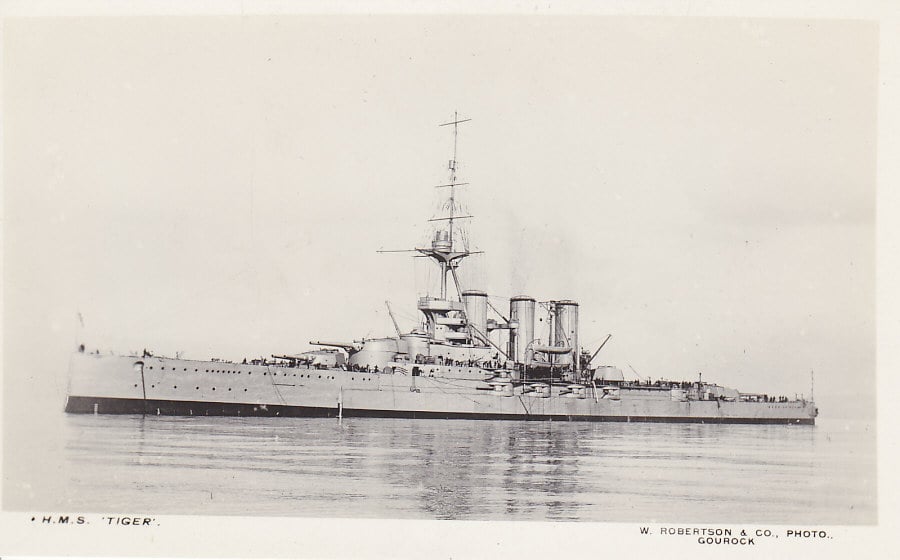
 www.tapatalk.com
www.tapatalk.com
HMS Hood as Laid Down

The Admiral class battlecruiser HMS Hood was an evolved design of Scheme 3, but a number of changes and improvements were incorporated into the design, namely a reduction in power to 144.000shp due to more accurate calculations and hull form tests, the increase of 5,5" secondary gun armament to 16 and armour scheme optimisation. After these changes the Admiralty approved the construction of 4 such ships:
HMS Hood, Anson, Howe and Rodney!
HMS Hood the first ship of the class was laid down first in May the 31st 1916, the day the Battle of Jutland happened which resulted in the intimidate halt of her construction due to the numerous battlecruiser losses in the battle. The ongoing investigation showed that the this ship type of the Royal Navy lacked adequate protection hence the first modification was the increase of the belt armour from 8" to 12" as well as the sloped part of the deck armour from 1-1,5" to 2". Apart from other structural changes an increased of torpedo armament was also approved and this modified design was accepted and HMS Hood was laid down the second time in September 1st 1916. Though the design continued to be changed and improved during it's construction.
The design had the following characteristics:
Dimensions: 246,9 (pp) x 259,2 (wl) x 262,13 (oa) x 31,7 x 7,8 meters
Displacement: 41.000tons (standard)
Armour: 305mm belt at 10°incline, 25mm over Machinery, 38mm over Magazines deck, 51-51mm slopes.
Engines: 144.000shp Parsons Steam Turbines, 4 shafts
Range: 14.200km at 30km/h (7.600nm at 16knots)
Speed: 58km/h (31knots)
Armaments:
4x2 15"/42 (381mm/42) BL Mark I Cannons,
16x1 5,5"/50 (140mm/50) BL Mark I Guns,
4x1 4"/42 (102mm/45) QF Mark V AA Guns,
2x1 53cm Underwater, 8x1 Above Water Torpedo Tubes
Modified Admiral Class Design A

During the re-design process of the Admiral class battlecruiser HMS Hood, DNC (Director of Naval Constructions) by the order of Admiral David Richard Beatty and the committee he formed after the battle of Jutland proposed 4 alternative designs to how to finish the ship. Though actually DNC thought of these proposals not as alternatives to the ‘Admirals’ but as a ship or ships to be built alongside them. The 4 proposals varied in main armament and displacement ranging from 4 twin 15" turrets to 4 triple ones and anything inbetween (2 twin 2 triples or simply 3 triples) which implies if one of the design was chosen the Hood's sisters would had been a separate class rather a somewhat modification of the completed ship.
Based on this I made a mixed look design based on Hood and her Sister ships with the set armaments as proposed.
The design had the following characteristics:
Dimensions: 246,9 (pp) x 259,2 (wl) x 262,13 (oa) x 31,7 x 7,8 meters
Displacement: 40.600tons (standard)
Armour: 305mm belt at 10°incline, 51mm deck, 51-51mm slopes.
Engines: 144.000shp Parsons Steam Turbines, 4 shafts
Range: 14.200km at 30km/h (7.600nm at 16knots)
Speed: 58km/h (31knots)
Armaments:
4x2 15"/42 (381mm/42) BL Mark I Cannons,
16x1 5,5"/50 (140mm/50) BL Mark I Guns,
4x1 4"/42 (102mm/45) QF Mark V AA Guns,
2x1 53cm Underwater, 2x1 Above Water Torpedo Tubes
Modified Admiral Class Design B

This drawing shows one of the alternative versions that DNC (Director of Naval Constructions) proposed to either finish the HMS Hood or to build alongside it. While Design A was the most economical alteration, Design B here shows how well the hull of the Admiral class battlecruisers built as it could accept even 4 triple turrets with ease without any changes in the principal dimension though 2.500 extra tons were required and the ammunition load reverted back to that of the pre WW1 standard: 80 shells per gun instead of 120 as the WW1 and post WW1 standard.
The design had the following characteristics:
Dimensions: 246,9 (pp) x 259,2 (wl) x 262,13 (oa) x 31,7 x 9,23 meters
Displacement: 43.100tons (standard)
Armour: 305mm belt at 10°incline, 51mm deck, 51-51mm slopes.
Engines: 144.000shp Parsons Steam Turbines, 4 shafts
Range: 14.200km at 30km/h (7.600nm at 16knots)
Speed: 56km/h (30knots)
Armaments:
4x3 15"/42 (381mm/42) BL Mark I Cannons,
16x1 5,5"/50 (140mm/50) BL Mark I Guns,
4x1 4"/42 (102mm/45) QF Mark V AA Guns,
2x1 53cm Underwater, 2x1 Above Water Torpedo Tubes
Modified Admiral Class Design C

This drawing shows one of the alternative versions that DNC (Director of Naval Constructions) proposed to either finish the HMS Hood or to build alongside it. While Design A was the most economical alteration and Design B was the most heavily armed, Design C and D were something inbetween. Design C here mixes the armament of A and B, eg mixed triple and twin turrets for a reduced increase in displacement of only 1.100tons though the ammunition load reverted back to that of the pre WW1 standard: 80 shells per gun instead of 120 as the WW1 and post WW1 standard.
The design had the following characteristics:
Dimensions: 246,9 (pp) x 259,2 (wl) x 262,13 (oa) x 31,7 x 8,93 meters
Displacement: 41.700tons (standard)
Armour: 305mm belt at 10°incline, 51mm deck, 51-51mm slopes.
Engines: 144.000shp Parsons Steam Turbines, 4 shafts
Range: 14.200km at 30km/h (7.600nm at 16knots)
Speed: 56km/h (30knots)
Armaments:
2x3,2x2 15"/42 (381mm/42) BL Mark I Cannons,
16x1 5,5"/50 (140mm/50) BL Mark I Guns,
4x1 4"/42 (102mm/45) QF Mark V AA Guns,
2x1 53cm Underwater, 2x1 Above Water Torpedo Tubes
Modified Admiral Class Design D

This drawing shows one of the alternative versions that DNC (Director of Naval Constructions) proposed to either finish the HMS Hood or to build alongside it. While Design B featured the maximum firepower with 4 triple 15" turrets, Design D is a somewhat rolled back proposal, utilising the triple turrets but only 3 in number reducing costs and displacement increase while still increasing the firepower over the original design. The 3 turrets meant only 300tons extra displacement had to be allocated. This 3 triple variant foreshadows the future of standard layout battleships: 3 triple turrets, 2 forward 1 aft.
The design had the following characteristics:
Dimensions: 246,9 (pp) x 259,2 (wl) x 262,13 (oa) x 31,7 x 8,93 meters
Displacement: 40.900tons (standard)
Armour: 305mm belt at 10°incline, 51mm deck, 51-51mm slopes.
Engines: 144.000shp Parsons Steam Turbines, 4 shafts
Range: 14.200km at 30km/h (7.600nm at 16knots)
Speed: 57km/h (30,75knots)
Armaments:
3x3 15"/42 (381mm/42) BL Mark I Cannons,
16x1 5,5"/50 (140mm/50) BL Mark I Guns,
4x1 4"/42 (102mm/45) QF Mark V AA Guns,
2x1 53cm Underwater, 2x1 Above Water Torpedo Tubes
HMS Hood's never were sister ships and the proposed 1938/39 modernisation
HMS Hood Sisters

While the Admiral class battlecruisers were to be a 4 strong ship class for the Royal Navy, only HMS Hood were finished and even her to a modified improved much more protected design. After the Battle of Jutland the class were redesigned with improved protection in mind and Hood's sister ships: HMS Anson, HMS Howe and HMS Rodney's construction were halted but due to more pressing matters and shifting construction priorities these 3 ships never continued in their construction. Still when they were not yet cancelled, in 1917 plans were drawn up to finish them a modified design compared to the lead ship: HMS Hood utilising war experience.
The changes included
- Removal of above water torpedo tubes
- The weather or Boat deck followed the layout of the 1st deck and thus creating a sort of roof over the 14cm single open mountings
- Funnels moved much closer to each other to make spotting the course of the ships more difficult
- Re designed and enhanced mainmast, topmast and fighting top facilities
- More compact and smaller Conning tower and bridge superstructure
Here I show you their look when they were re-designed in 1917 still showing their full complement of 16x 14cm or 5,5" guns instead the as finished 12 mounts (Reduced on Hood due to weight increase from carious armour thickness changes)
HMS Hood Modernization Proposal

After the First and later the Second London Naval Treaties which forbid (First) the construction of new capital ships but allowed the modernizations and extensive refits of existing ones to improve their fighting capabilities of the signatory nations. For the RN this meant plans were drawn up to modernize their capital ship fleet, to be precise the Renown and Hood class Battlecruisers and the Queen Elizabeth and Nelson class Battleships. The Revenges were deemed for replacement by the newly designed and built King George Class Battleships while the Queen Elizabeths by the Lion class battleships hence the Revenges were never received their extensive refit and the QE's got different modernization proposals to test the new technologies. But there were 3 chokepoints for these rebuilds:
- The Naval Budget
- The capacities of the various shipyards
- The gun and turret manufacturing industry
The Royal Navy had to prioritise which classes and which ships were to be modernized first and they decided that the order was:
Valiant (1st phase)
Barham (1st phase)
Malaya (1st phase)
Warspite
Valiant
Queen Elizabeth
Renown
Repulse
Hood
Nelson
Rodney
But due to shipyard capacity and the war the last 3 (Hood, Nelson, Rodney) and the full modernisations of Barham and Malaya were not carried out still plans and proposals were made for these ships. Here I show you the KGV style modernization scheme for Hood which if were finished would made the ship well protected against both surface threats by improving her armour and both air threats by vastly increasing her AA armament. Her machinery too would had been replaced but it is not known by what kind. Refurbishment of the turbines? Replacement of the Boilers? Full machinery overhaul?
The design had the following characteristics:
Dimensions: 246,9 (pp) x 259,2 (wl) x 262,13 (oa) x 31,7 x 8,7 meters
Displacement: 46.000tons (standard)
Armour: 305mm belt at 10°incline, 76mm over Machinery, 102mm over Magazines deck, 102mm slopes.
Engines: Unknown, minimum 150-160.000shp Parsons Steam Turbines, 4 shafts
Range: 14.200km at 30km/h (7.600nm at 16knots)
Speed: 57km/h (30,75knots)
Armaments:
4x2 15"/42 (381mm/42) BL Mark I Cannons,
8x2 5,25"/50 (133mm/50) QF Mark I Guns,
6x8 40mm/39 QF Mark VIII Pom-Pom AA Guns,
6x4 12,7mm/62 MG Mark III AA Guns
Sensor suite:
2x Type 79 Air-search Radar on both of the masts
1x Type 273 Surface search Radar on the mainmast fighting top or "starfish" structure
1x Type 281 Air-warning Radar on top of the aft mast
6x Type 282 Fire-control Radar sets one for each Pom-Pom director
2x Type 284 Fire-control Radar on the main armament director/rangefinders
4x Type 285 Fire-control Radar sets one for each secondary armament director/rangefinder
2x Type 290 Air-warning Radar on top of the masts
So let's start with the six preliminary proposals:
Official documents:
i.imgur.com/zhb2wxR.jpg
i.imgur.com/fIjE20R.jpg
i.imgur.com/n1Kwcwp.jpg
i.imgur.com/hje3Yhb.jpg
Battlecruiser Design 1916 Scheme 1
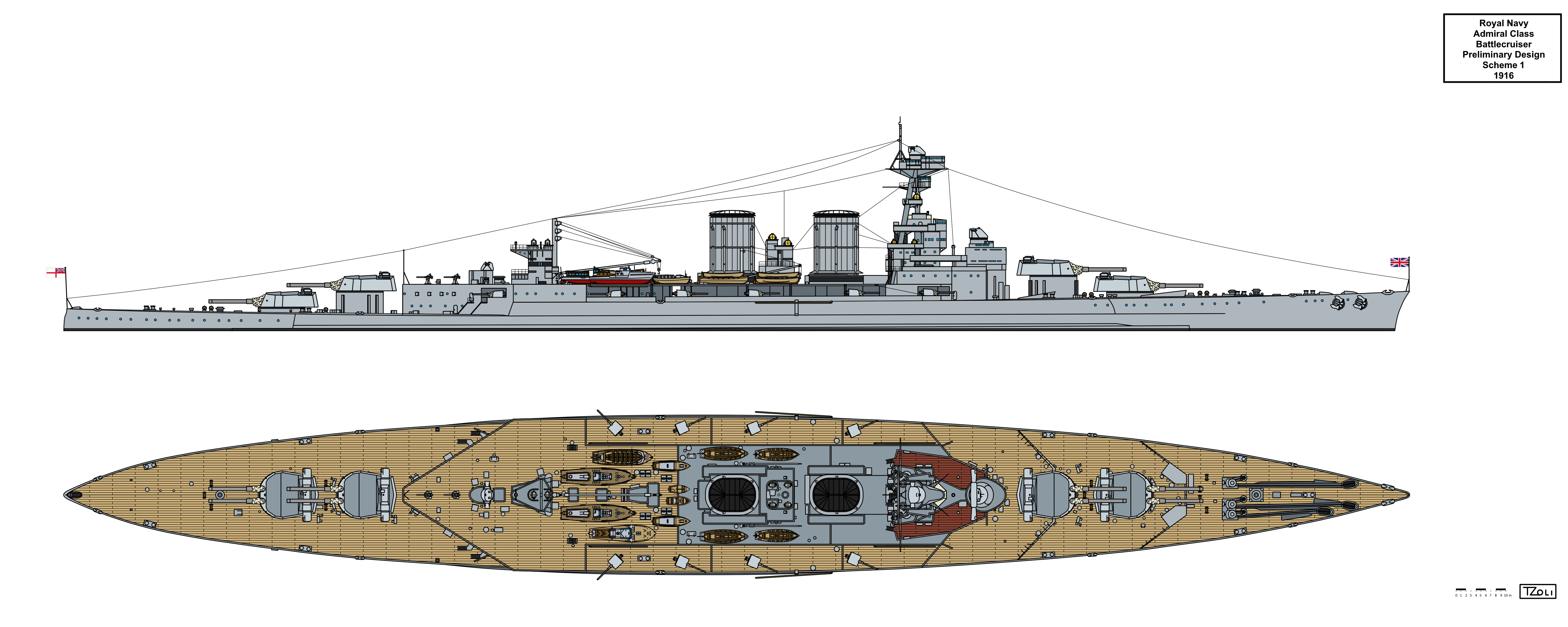
The Origins of the Admiral class Battlecruisers or as more commonly known HMS Hood could be traced back to the 1915 when Admiral of the Fleet John Rushworth Jellicoe required more 15" armed warships as soon as possible, hence DNC started working on an improved Queen Elizabeth type with 4x2 15" and 12x1 5" armament together with 4x1 21" underwater torpedo tubes. A number of designs were born: A,B,C1,C2 and D. All of them were forwarded to Jellicoe, but he discarded them as he did not wanted new battleships at all saying the overall superiority of the type in the hands of the Royal Navy.
He considered the numbers of battlecruisers too small compared to the Germans, who were already building at least three very fast and powerful battlecruisers: SMS Hindenburg, SMS Mackensen and SMS Prinz Eitel Friedrich, in addition to SMS Lützow.
He thought had no use for DNC’s fusion aka fastbattleships, he wanted true slow battleships or 30-knot battlecruisers. His view was partly based on disappointment with the Queen Elizabeths, whose limited speed made it ‘questionable whether they
will be able to get to the head of the line on deployment without blanketing the battle line’. Given their light protection, none of Fisher’s new ships (HMS Renown and Repulse) could fight German battlecruisers. But there were no battlecruiser designs ready at that time so DNC had to use designs privately created by Sir Eustace Henry William Tennyson d'Eyncourt, lead naval architect of the RN by the request of Admiral John Arbuthnot Fisher, Many of these designs featured the new 18" gun of Fisher which the RN had no interest in! This might be a reason why the Admiral class in her original design having soo larger hull than a 4 turreted Renown despite the same armour and speed! They might had designed to carry something much heavier than the 15"/42 BL Mark I cannons of the time...
Design I was the first in the series proposed for Jellicoe for a new construction battlecruiser. With it's layout of both primary and secondary armament as well as in number it is very similar to the HMS Hood as ordered although the number of 5,5" guns only counted to 12 and the AA guns were the standard early WW1 selection of two single 3" ones. What is most striking was the size of the design: 269,75m overall some 7m longer than Hood despite the lower engine output and thus slower speed. The reason behind this are the choice of Babcock & Wilcox type large tube boilers, identical to that of the Renown class battlecruiser and which driven up both hull size and tonnage. Based on their power output, around 42 such boilers would had been required for the desired 120.000shp which is quite a considerable number to the final design's 144.000shp and 24 Yarrow Small Tube boilers!
Another striking difference was the lack of mainmast aft which allowed an easier opportunity of the enemy (according to Jellicoe) to determine the ship's direction. hence only the crane's smaller mast I put there.
The design had the following characteristics:
Dimensions: 254,51 (pp) x 266,82 (wl) x 269,75 (oa) x 31,7 x 7,92 meters
Displacement: 39.000tons (standard)
Armour: 203mm belt at 10°incline, 25mm over Machinery, 38mm over Magazines deck, 38-38mm slopes.
Engines: 120.000shp Parsons Steam Turbines, 4 shafts
Range: 14.200km at 30km/h (7.600nm at 16knots)
Speed: 56km/h (30knots)
Armaments:
4x2 15"/42 (381mm/42) BL Mark I Cannons,
12x1 5,5"/50 (140mm/50) BL Mark I Guns,
2x1 3"/42 (76mm/45) QF HA Mark I AA Guns,
2x1 53cm Underwater Torpedo Tubes
Battlecruiser Design 1916 Scheme 2
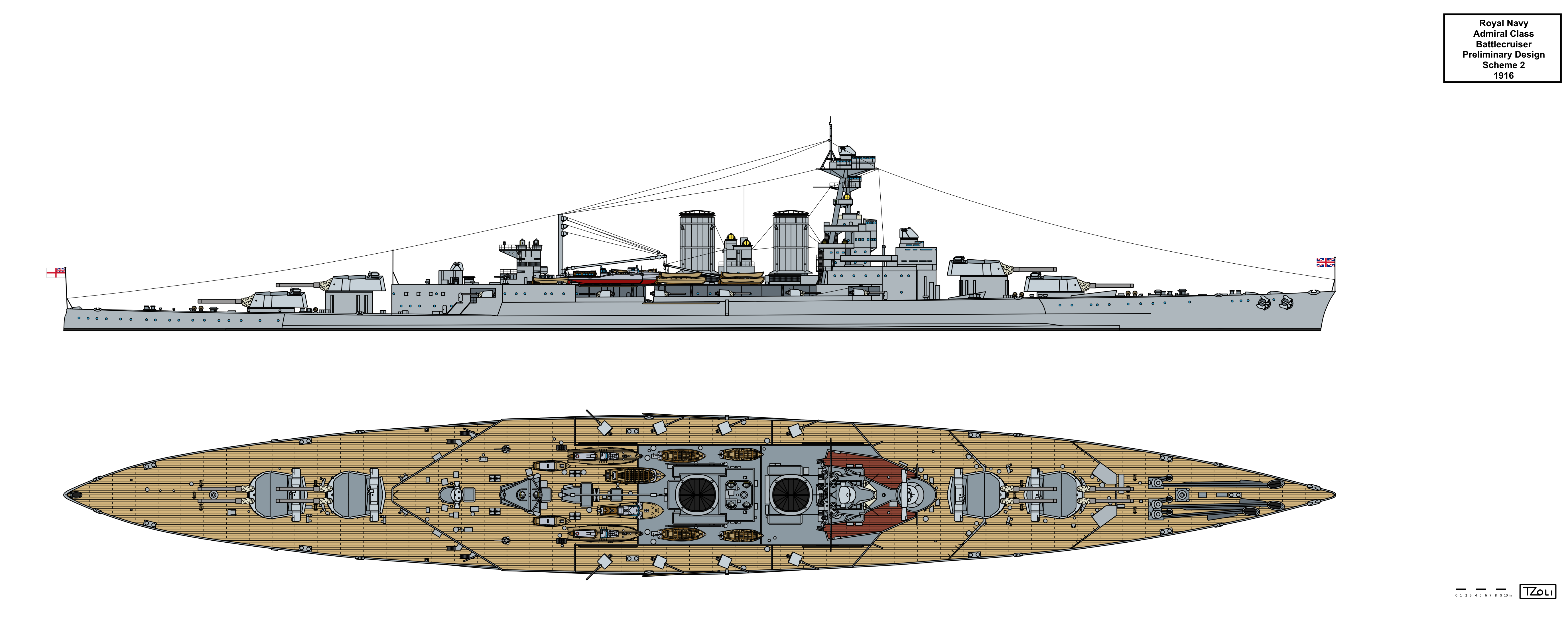
Design II was the second in the series proposed for Jellicoe for a new construction battlecruiser. It is essentially the same as Scheme 1 but using Yarrow small tube boilers instead of Babcock & Wilcox type large tube boilers for the same 120.000shp. As you can see, development in engine technology allowed the designers to produce ships with smaller machinery space yet more power output! I calculate that around 20 Yarrow Small Tube boilers were required for the desired power output. This resulted in a much shorter proposal of roughly 14m shorter hull together with the weight saving in armour to protect the hull with a considerable 3.500tons sving in displacement! Otherwise like armament layout armour speed etc it is identical to that of Scheme 1.
The design had the following characteristics:
Dimensions: 240,79 (pp) x 253,1 (wl) x 256,03 (oa) x 31,7 x 7,92 meters
Displacement: 35.500tons (standard)
Armour: 203mm belt at 10°incline, 25mm over Machinery, 38mm over Magazines deck, 38-38mm slopes.
Engines: 120.000shp Parsons Steam Turbines, 4 shafts
Range: 14.200km at 30km/h (7.600nm at 16knots)
Speed: 56km/h (30knots)
Armaments:
4x2 15"/42 (381mm/42) BL Mark I Cannons,
12x1 5,5"/50 (140mm/50) BL Mark I Guns,
2x1 3"/42 (76mm/45) QF HA Mark I AA Guns,
2x1 53cm Underwater Torpedo Tubes
Battlecruiser Design 1916 Scheme 3
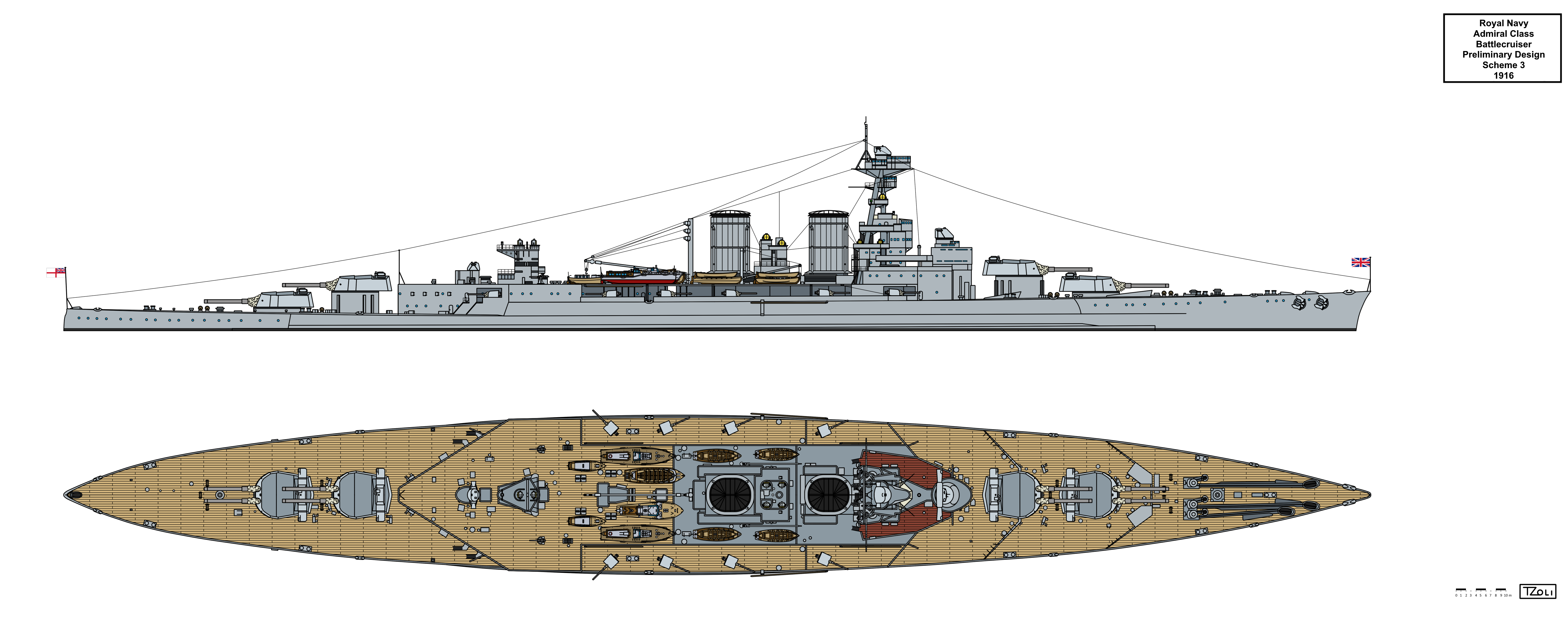
Design III was the third in the series proposed for Jellicoe for a new construction battlecruiser. While the previous proposals were 30knot versions, here d'Eyncourt calculated that by lengthened the hull and increasing the engine power to 160.000shp a higher 32knot or 59km maximum speed could be reached. Other aspects was identical to the other two previous proposals. Among the 6 designs the Admiralty chose this, Scheme 3 for further development which eventually became the Admiral class Battlecruiser HMS Hood.
The design had the following characteristics:
Dimensions: 246,9 (pp) x 259,2 (wl) x 262,13 (oa) x 31,7 x 7,62 meters
Displacement: 36.300tons (standard)
Armour: 203mm belt at 10°incline, 25mm over Machinery, 38mm over Magazines deck, 38-38mm slopes.
Engines: 160.000shp Parsons Steam Turbines, 4 shafts
Range: 14.200km at 30km/h (7.600nm at 16knots)
Speed: 59km/h (32knots)
Armaments:
4x2 15"/42 (381mm/42) BL Mark I Cannons,
12x1 5,5"/50 (140mm/50) BL Mark I Guns,
2x1 3"/42 (76mm/45) QF HA Mark I AA Guns,
2x1 53cm Underwater Torpedo Tubes
Battlecruiser Design 1916 Scheme 4
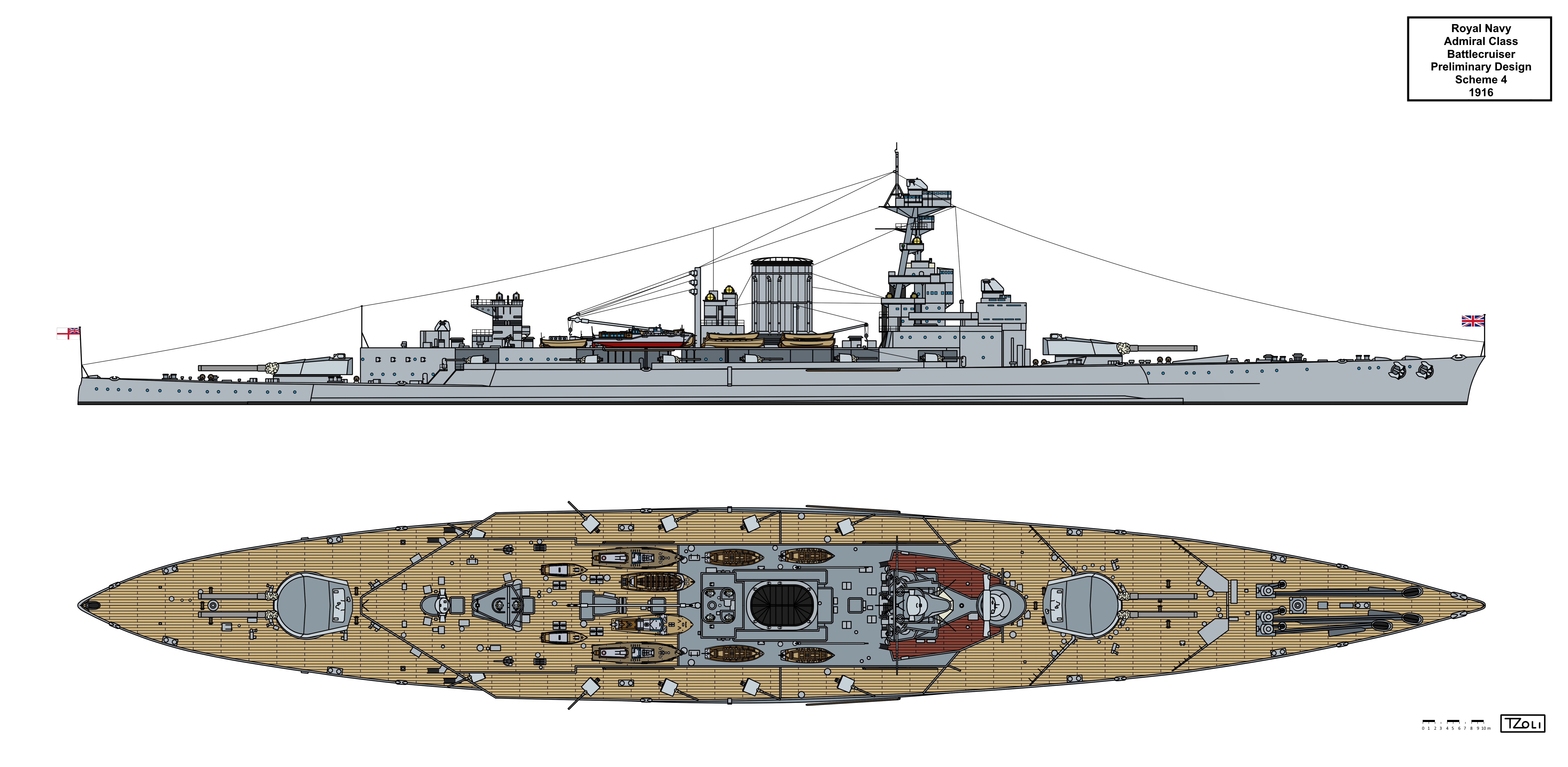
Design IV was the fourth in the series proposed for Jellicoe for a new construction battlecruiser. But this is the first true capital ship designed in the RN to carry a meaningful number of 18" weapons! You can think of it as a mix of Hood, Courageous/Glorious and Furious. The use of only two twin turrets meant that the protective citadel and thus the entire hull could be shortened drastically saving costs. The engine power remained the same as of Scheme 2 and I've used a single thick funnel to further differentiate this proposal from the rest.
The design had the following characteristics:
Dimensions: 216,41 (pp) x 227,8 (wl) x 230,73 (oa) x 31,7 x 7,62 meters
Displacement: 32.500tons (standard)
Armour: 203mm belt at 10°incline, 25mm over Machinery, 38mm over Magazines deck, 38-38mm slopes.
Engines: 120.000shp Parsons Steam Turbines, 4 shafts
Range: 14.200km at 30km/h (7.600nm at 16knots)
Speed: 56km/h (30knots)
Armaments:
2x2 18"/40 (457mm/40) BL Mark I Cannons,
12x1 5,5"/50 (140mm/50) BL Mark I Guns,
2x1 3"/42 (76mm/45) QF HA Mark I AA Guns,
2x1 53cm Underwater Torpedo Tubes
Battlecruiser Design 1916 Scheme 5
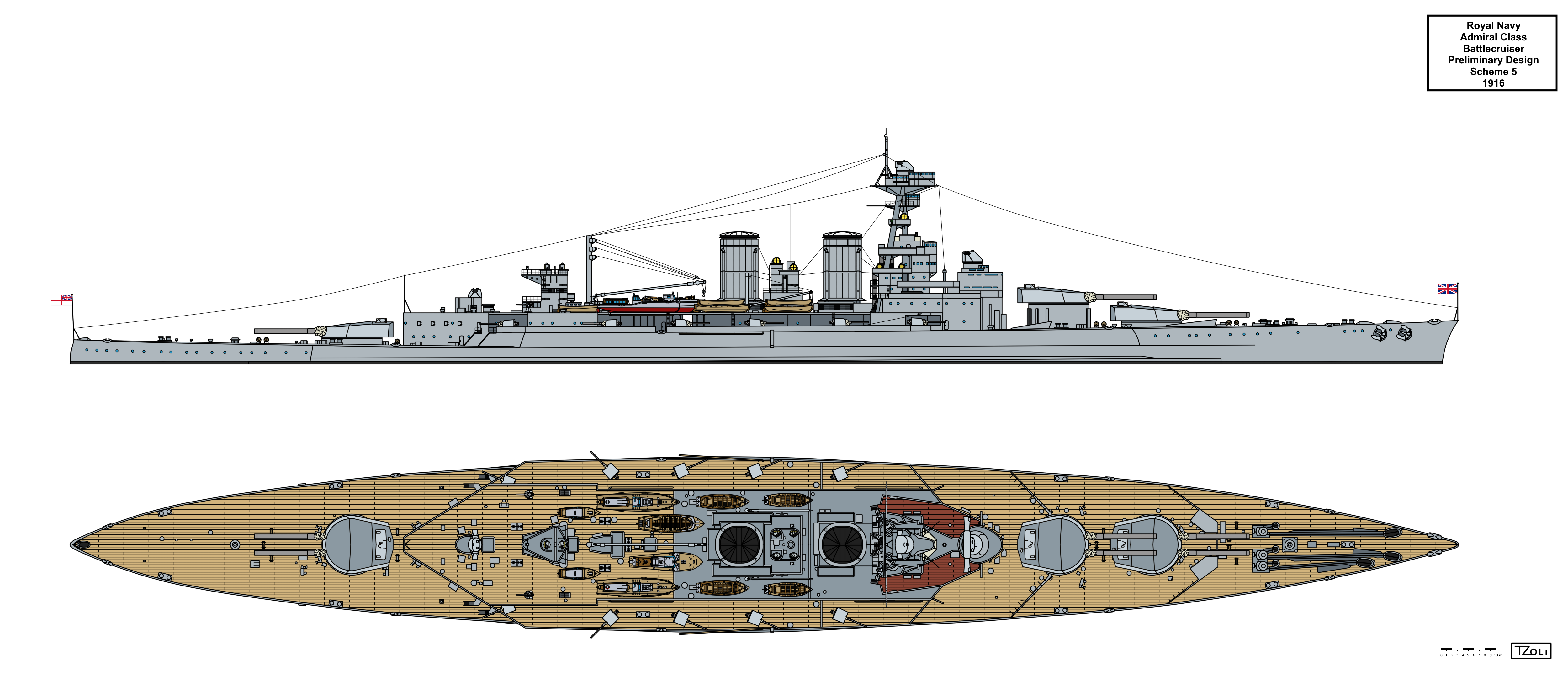
Design V was the fifth in the series proposed for Jellicoe for a new construction battlecruiser. This design is much better looking warship both armament and ship size wise. The hull is just a few meters shorter to that of design 2 and uses the same powerplant but the larger turrets meant that even with 3 turrets the hull got only 3meters shorter. If the Admiralty would had been considered the 18" gun this ship would be a likely candidate for construction having some 800tons lighter than Design 3 which was chosen for further development. You can see this proposal if you will a Hoodified Renown with 18" turrets.
The design had the following characteristics:
Dimensions: 237,74 (pp) x 250,05 (wl) x 253 (oa) x 31,7 x 7,62 meters
Displacement: 35.500tons (standard)
Armour: 203mm belt at 10°incline, 25mm over Machinery, 38mm over Magazines deck, 38-38mm slopes.
Engines: 120.000shp Parsons Steam Turbines, 4 shafts
Range: 14.200km at 30km/h (7.600nm at 16knots)
Speed: 56km/h (30knots)
Armaments:
3x2 18"/40 (457mm/40) BL Mark I Cannons,
12x1 5,5"/50 (140mm/50) BL Mark I Guns,
2x1 3"/42 (76mm/45) QF HA Mark I AA Guns,
2x1 53cm Underwater Torpedo Tubes
Battlecruiser Design 1916 Scheme 6
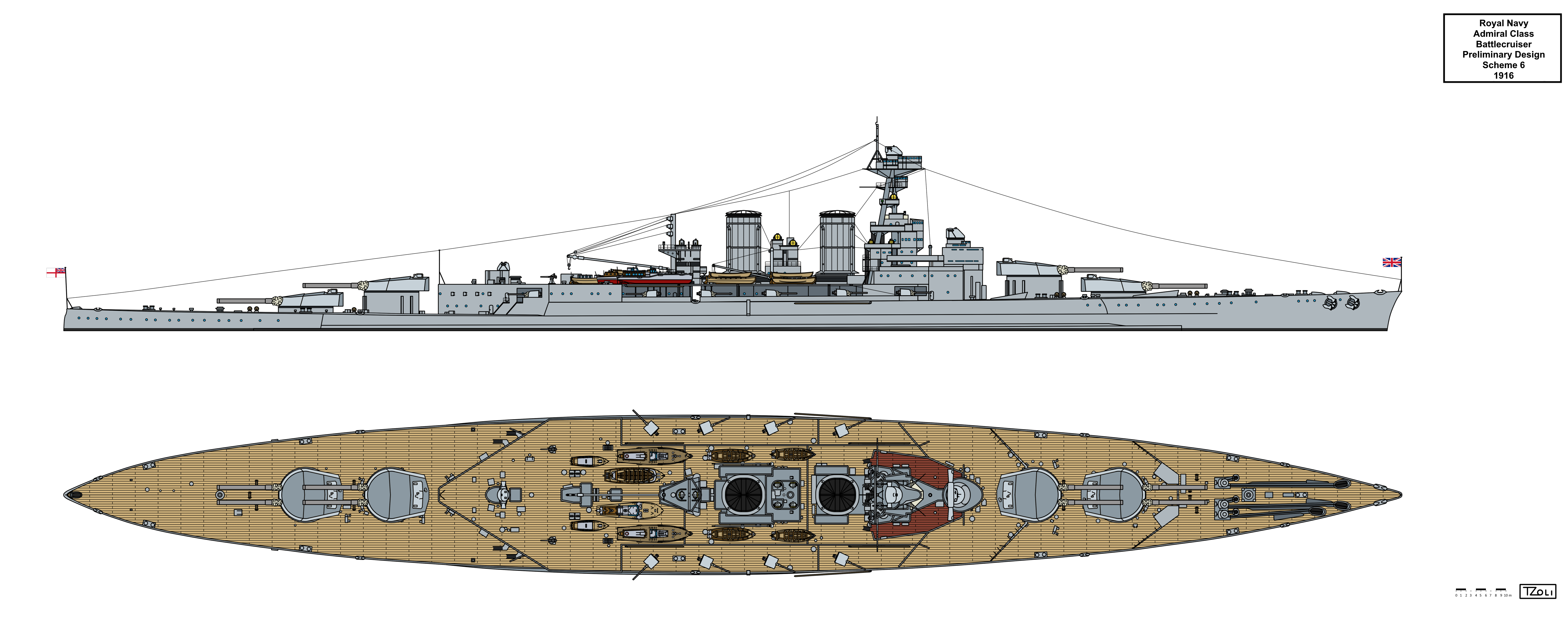
Design VI was the sixth and last in the series proposed for Jellicoe for a new construction battlecruiser. This design despite not the largest proposal but both the heaviest and most heavily armed version with 8 18" cannons mounted in 4 twin turrets. You can sort of call it the Super Hood despite it is a design preceding it because the 18" cannons would certainly hit quite a punch in the enemy battleline. This was the last of the Admiral class preliminary studies and the last capital ship design to my knowledge to feature 18" weaponry till the 1920's with the N3/G3 design process started and all the experiences of the Great War got processed and thought over.
But this was not the end of the big guns in the Royal Navy, while Admiral Fisher still had influence he proposed a Super Furious with single 20" cannons as well as some of the HMS Incomparable studies which also featured this fearsome weapon!
The design had the following characteristics:
Dimensions: 252,98 (pp) x 265,29 (wl) x 268,22 (oa) x 31,7 x 7,92 meters
Displacement: 39.500tons (standard)
Armour: 203mm belt at 10°incline, 25mm over Machinery, 38mm over Magazines deck, 38-38mm slopes.
Engines: 120.000shp Parsons Steam Turbines, 4 shafts
Range: 14.200km at 30km/h (7.600nm at 16knots)
Speed: 56km/h (30knots)
Armaments:
4x2 18"/40 (457mm/40) BL Mark I Cannons,
12x1 5,5"/50 (140mm/50) BL Mark I Guns,
2x1 3"/42 (76mm/45) QF HA Mark I AA Guns,
2x1 53cm Underwater Torpedo Tubes
The Hood as laid down and the alternative designs
Some Extra info:

All the World's Battlecruisers-What if, 18" Hood effect on WNT and the Hunt for Bismarck
Not sure if you guys know but there were 6 preliminary designs which was used as a basis for developing the Admiral class battlecruisers and HMS Hood.
HMS Hood as Laid Down
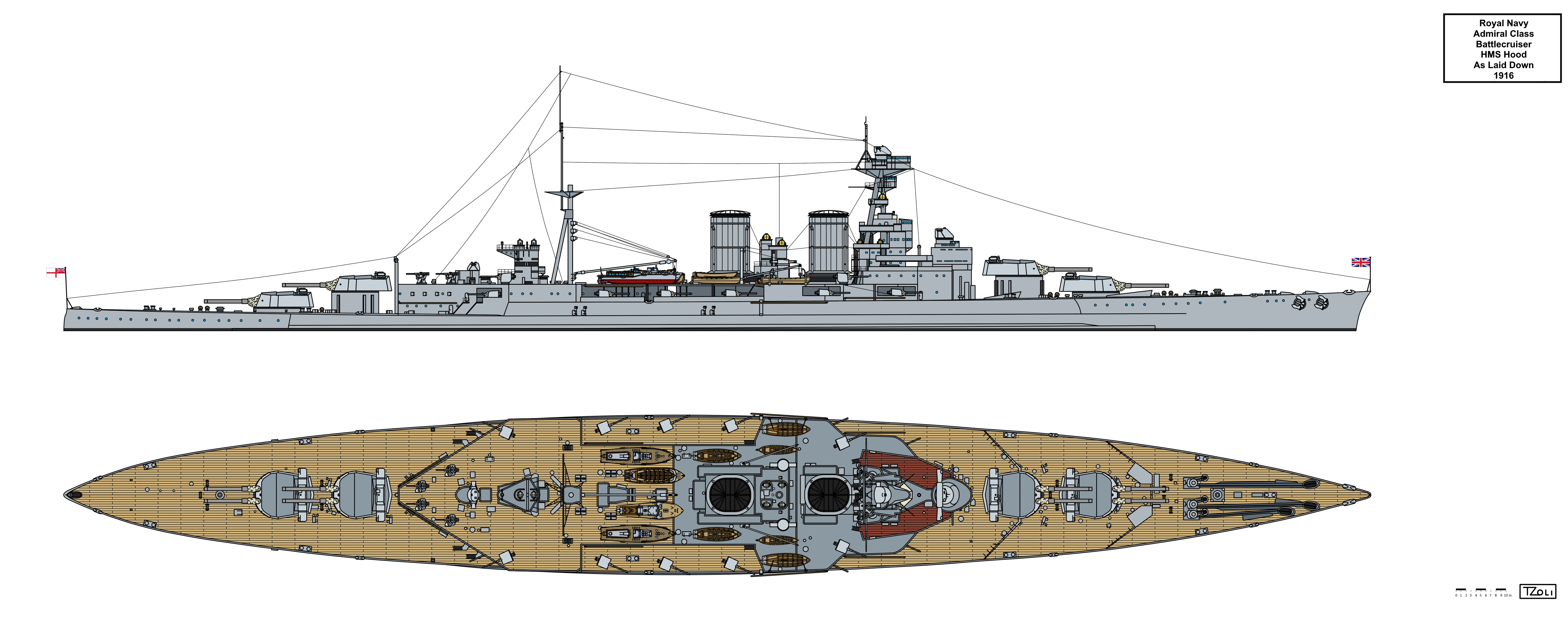
The Admiral class battlecruiser HMS Hood was an evolved design of Scheme 3, but a number of changes and improvements were incorporated into the design, namely a reduction in power to 144.000shp due to more accurate calculations and hull form tests, the increase of 5,5" secondary gun armament to 16 and armour scheme optimisation. After these changes the Admiralty approved the construction of 4 such ships:
HMS Hood, Anson, Howe and Rodney!
HMS Hood the first ship of the class was laid down first in May the 31st 1916, the day the Battle of Jutland happened which resulted in the intimidate halt of her construction due to the numerous battlecruiser losses in the battle. The ongoing investigation showed that the this ship type of the Royal Navy lacked adequate protection hence the first modification was the increase of the belt armour from 8" to 12" as well as the sloped part of the deck armour from 1-1,5" to 2". Apart from other structural changes an increased of torpedo armament was also approved and this modified design was accepted and HMS Hood was laid down the second time in September 1st 1916. Though the design continued to be changed and improved during it's construction.
The design had the following characteristics:
Dimensions: 246,9 (pp) x 259,2 (wl) x 262,13 (oa) x 31,7 x 7,8 meters
Displacement: 41.000tons (standard)
Armour: 305mm belt at 10°incline, 25mm over Machinery, 38mm over Magazines deck, 51-51mm slopes.
Engines: 144.000shp Parsons Steam Turbines, 4 shafts
Range: 14.200km at 30km/h (7.600nm at 16knots)
Speed: 58km/h (31knots)
Armaments:
4x2 15"/42 (381mm/42) BL Mark I Cannons,
16x1 5,5"/50 (140mm/50) BL Mark I Guns,
4x1 4"/42 (102mm/45) QF Mark V AA Guns,
2x1 53cm Underwater, 8x1 Above Water Torpedo Tubes
Modified Admiral Class Design A
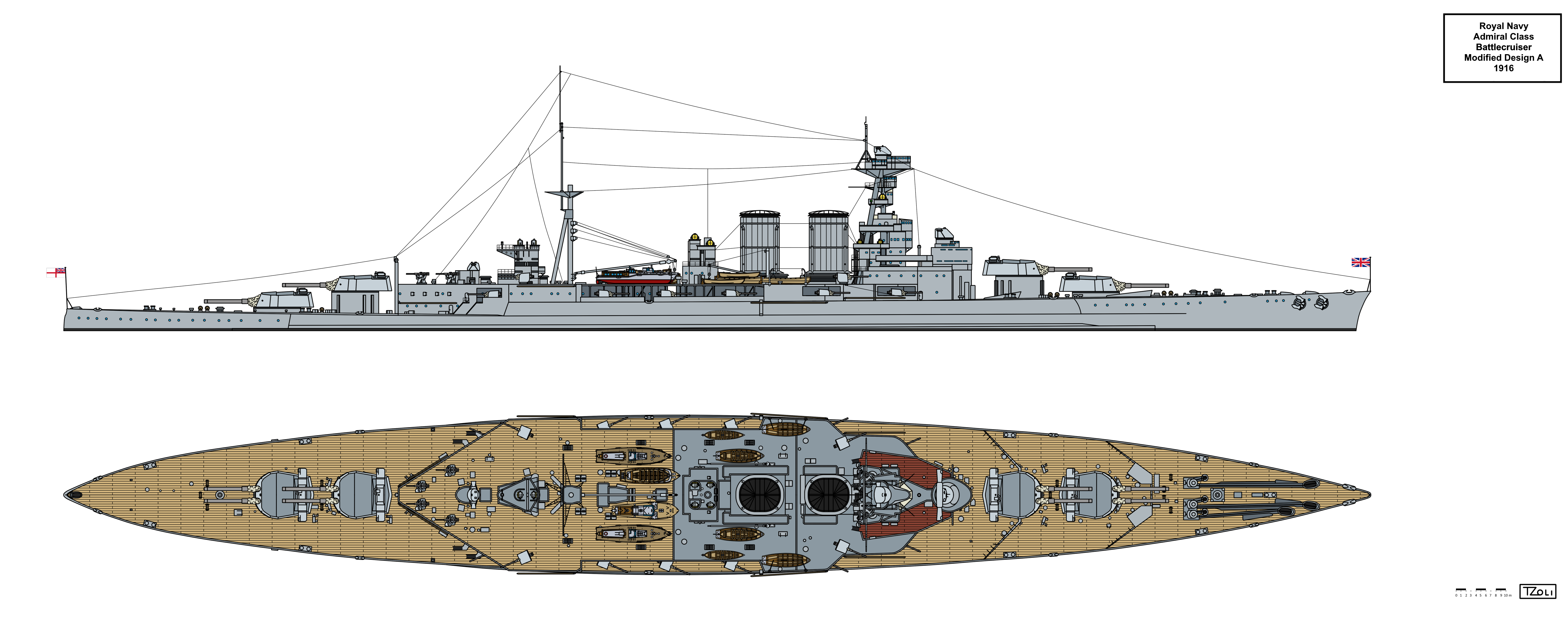
During the re-design process of the Admiral class battlecruiser HMS Hood, DNC (Director of Naval Constructions) by the order of Admiral David Richard Beatty and the committee he formed after the battle of Jutland proposed 4 alternative designs to how to finish the ship. Though actually DNC thought of these proposals not as alternatives to the ‘Admirals’ but as a ship or ships to be built alongside them. The 4 proposals varied in main armament and displacement ranging from 4 twin 15" turrets to 4 triple ones and anything inbetween (2 twin 2 triples or simply 3 triples) which implies if one of the design was chosen the Hood's sisters would had been a separate class rather a somewhat modification of the completed ship.
Based on this I made a mixed look design based on Hood and her Sister ships with the set armaments as proposed.
The design had the following characteristics:
Dimensions: 246,9 (pp) x 259,2 (wl) x 262,13 (oa) x 31,7 x 7,8 meters
Displacement: 40.600tons (standard)
Armour: 305mm belt at 10°incline, 51mm deck, 51-51mm slopes.
Engines: 144.000shp Parsons Steam Turbines, 4 shafts
Range: 14.200km at 30km/h (7.600nm at 16knots)
Speed: 58km/h (31knots)
Armaments:
4x2 15"/42 (381mm/42) BL Mark I Cannons,
16x1 5,5"/50 (140mm/50) BL Mark I Guns,
4x1 4"/42 (102mm/45) QF Mark V AA Guns,
2x1 53cm Underwater, 2x1 Above Water Torpedo Tubes
Modified Admiral Class Design B
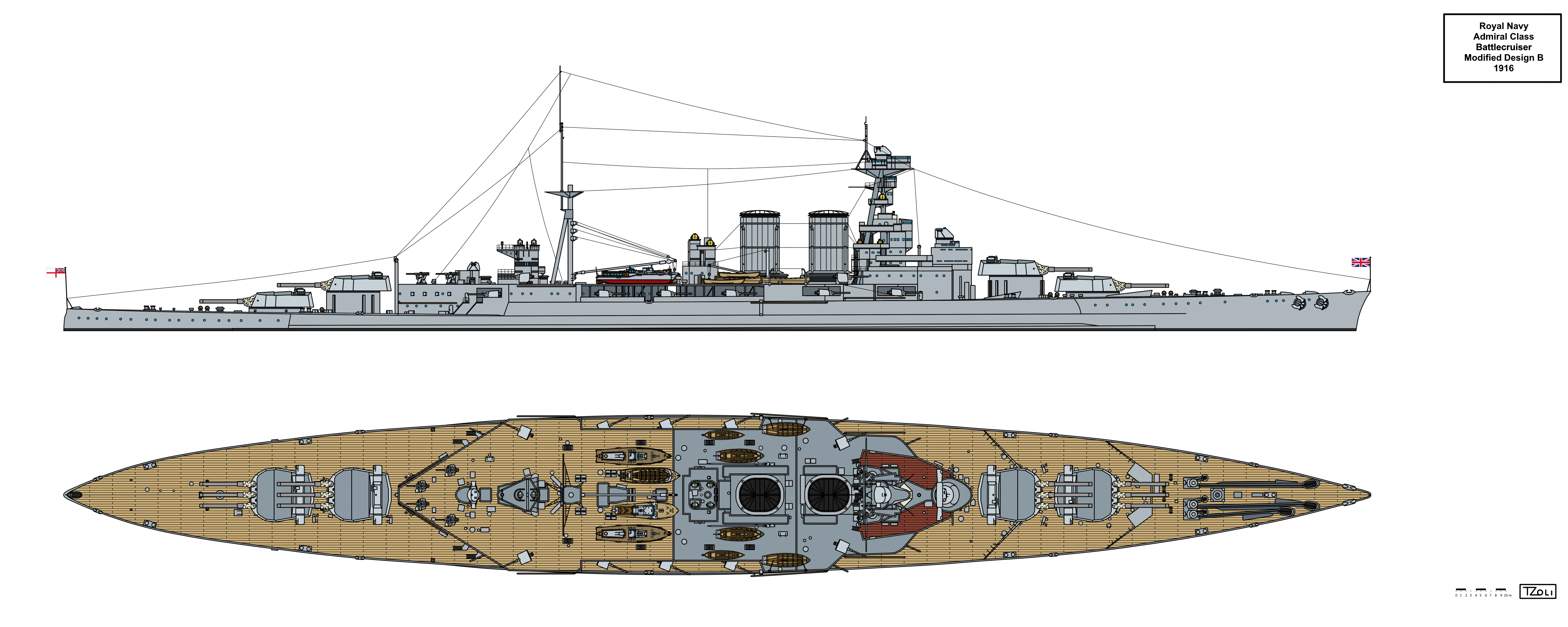
This drawing shows one of the alternative versions that DNC (Director of Naval Constructions) proposed to either finish the HMS Hood or to build alongside it. While Design A was the most economical alteration, Design B here shows how well the hull of the Admiral class battlecruisers built as it could accept even 4 triple turrets with ease without any changes in the principal dimension though 2.500 extra tons were required and the ammunition load reverted back to that of the pre WW1 standard: 80 shells per gun instead of 120 as the WW1 and post WW1 standard.
The design had the following characteristics:
Dimensions: 246,9 (pp) x 259,2 (wl) x 262,13 (oa) x 31,7 x 9,23 meters
Displacement: 43.100tons (standard)
Armour: 305mm belt at 10°incline, 51mm deck, 51-51mm slopes.
Engines: 144.000shp Parsons Steam Turbines, 4 shafts
Range: 14.200km at 30km/h (7.600nm at 16knots)
Speed: 56km/h (30knots)
Armaments:
4x3 15"/42 (381mm/42) BL Mark I Cannons,
16x1 5,5"/50 (140mm/50) BL Mark I Guns,
4x1 4"/42 (102mm/45) QF Mark V AA Guns,
2x1 53cm Underwater, 2x1 Above Water Torpedo Tubes
Modified Admiral Class Design C
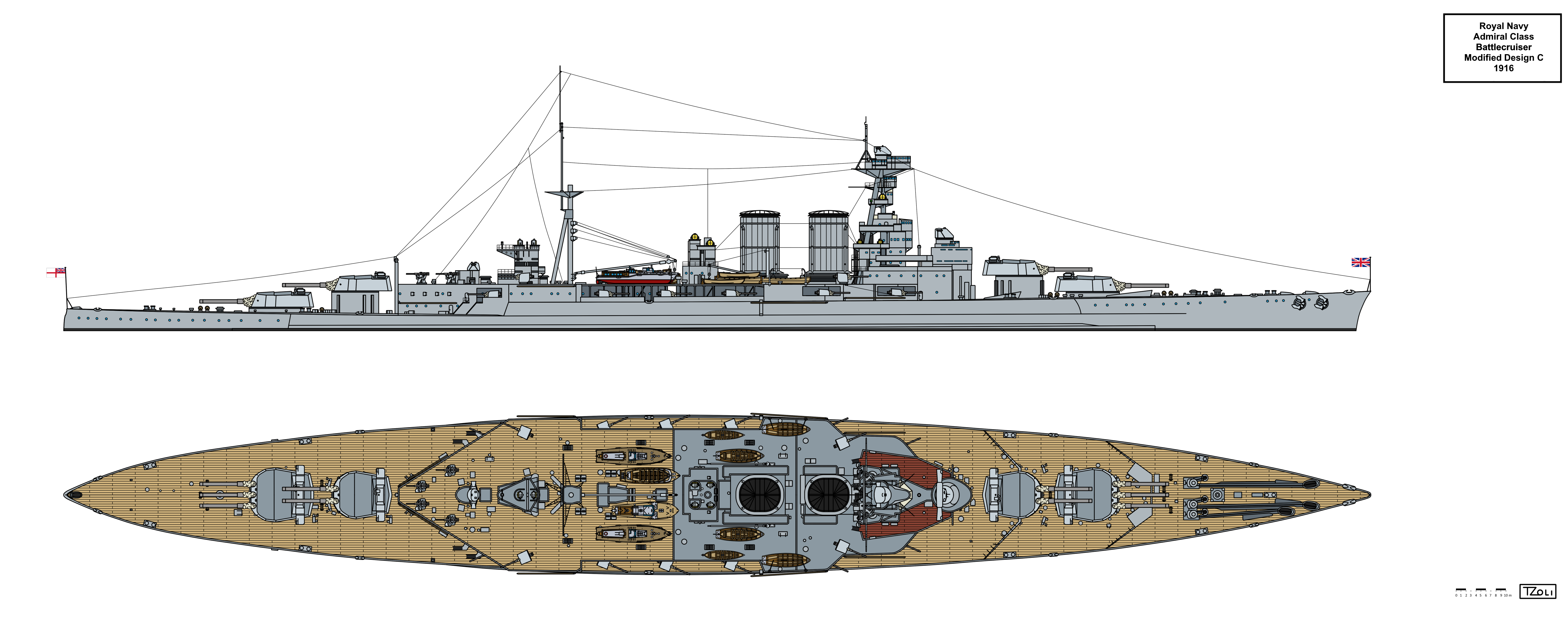
This drawing shows one of the alternative versions that DNC (Director of Naval Constructions) proposed to either finish the HMS Hood or to build alongside it. While Design A was the most economical alteration and Design B was the most heavily armed, Design C and D were something inbetween. Design C here mixes the armament of A and B, eg mixed triple and twin turrets for a reduced increase in displacement of only 1.100tons though the ammunition load reverted back to that of the pre WW1 standard: 80 shells per gun instead of 120 as the WW1 and post WW1 standard.
The design had the following characteristics:
Dimensions: 246,9 (pp) x 259,2 (wl) x 262,13 (oa) x 31,7 x 8,93 meters
Displacement: 41.700tons (standard)
Armour: 305mm belt at 10°incline, 51mm deck, 51-51mm slopes.
Engines: 144.000shp Parsons Steam Turbines, 4 shafts
Range: 14.200km at 30km/h (7.600nm at 16knots)
Speed: 56km/h (30knots)
Armaments:
2x3,2x2 15"/42 (381mm/42) BL Mark I Cannons,
16x1 5,5"/50 (140mm/50) BL Mark I Guns,
4x1 4"/42 (102mm/45) QF Mark V AA Guns,
2x1 53cm Underwater, 2x1 Above Water Torpedo Tubes
Modified Admiral Class Design D
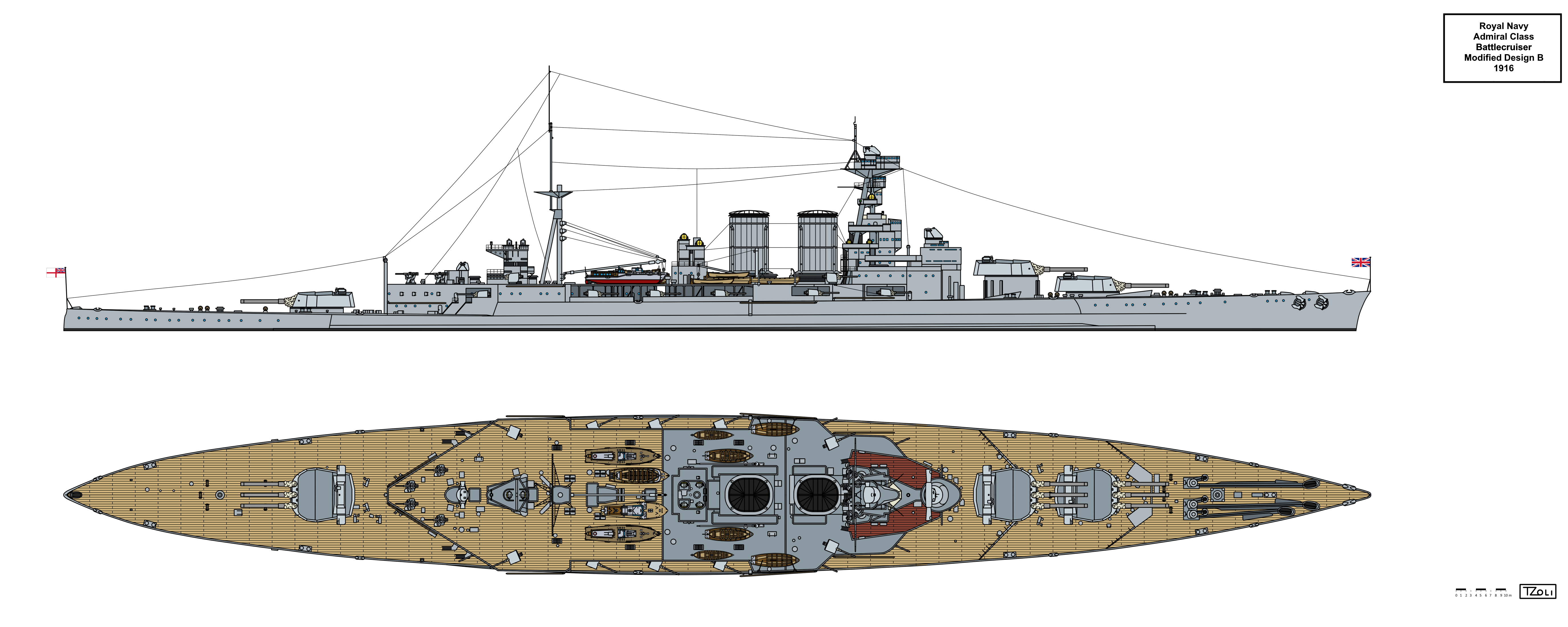
This drawing shows one of the alternative versions that DNC (Director of Naval Constructions) proposed to either finish the HMS Hood or to build alongside it. While Design B featured the maximum firepower with 4 triple 15" turrets, Design D is a somewhat rolled back proposal, utilising the triple turrets but only 3 in number reducing costs and displacement increase while still increasing the firepower over the original design. The 3 turrets meant only 300tons extra displacement had to be allocated. This 3 triple variant foreshadows the future of standard layout battleships: 3 triple turrets, 2 forward 1 aft.
The design had the following characteristics:
Dimensions: 246,9 (pp) x 259,2 (wl) x 262,13 (oa) x 31,7 x 8,93 meters
Displacement: 40.900tons (standard)
Armour: 305mm belt at 10°incline, 51mm deck, 51-51mm slopes.
Engines: 144.000shp Parsons Steam Turbines, 4 shafts
Range: 14.200km at 30km/h (7.600nm at 16knots)
Speed: 57km/h (30,75knots)
Armaments:
3x3 15"/42 (381mm/42) BL Mark I Cannons,
16x1 5,5"/50 (140mm/50) BL Mark I Guns,
4x1 4"/42 (102mm/45) QF Mark V AA Guns,
2x1 53cm Underwater, 2x1 Above Water Torpedo Tubes
HMS Hood's never were sister ships and the proposed 1938/39 modernisation
HMS Hood Sisters
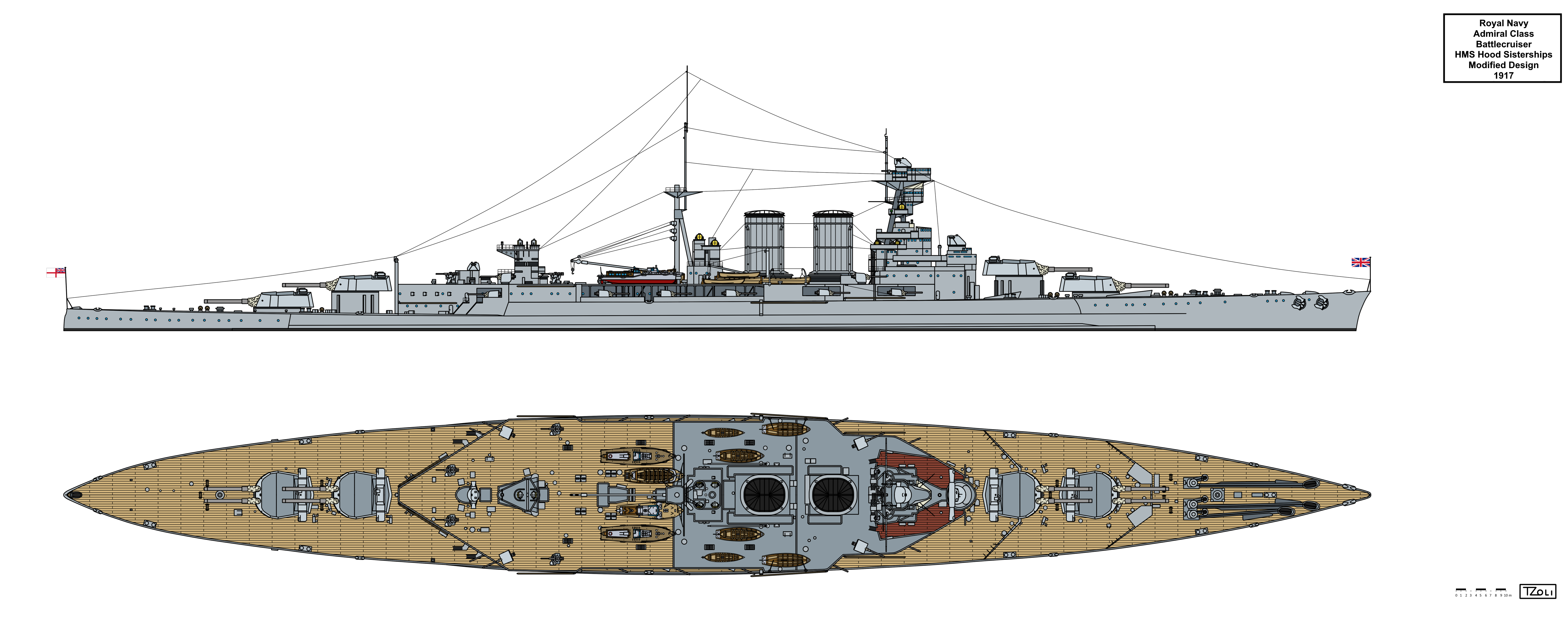
While the Admiral class battlecruisers were to be a 4 strong ship class for the Royal Navy, only HMS Hood were finished and even her to a modified improved much more protected design. After the Battle of Jutland the class were redesigned with improved protection in mind and Hood's sister ships: HMS Anson, HMS Howe and HMS Rodney's construction were halted but due to more pressing matters and shifting construction priorities these 3 ships never continued in their construction. Still when they were not yet cancelled, in 1917 plans were drawn up to finish them a modified design compared to the lead ship: HMS Hood utilising war experience.
The changes included
- Removal of above water torpedo tubes
- The weather or Boat deck followed the layout of the 1st deck and thus creating a sort of roof over the 14cm single open mountings
- Funnels moved much closer to each other to make spotting the course of the ships more difficult
- Re designed and enhanced mainmast, topmast and fighting top facilities
- More compact and smaller Conning tower and bridge superstructure
Here I show you their look when they were re-designed in 1917 still showing their full complement of 16x 14cm or 5,5" guns instead the as finished 12 mounts (Reduced on Hood due to weight increase from carious armour thickness changes)
HMS Hood Modernization Proposal
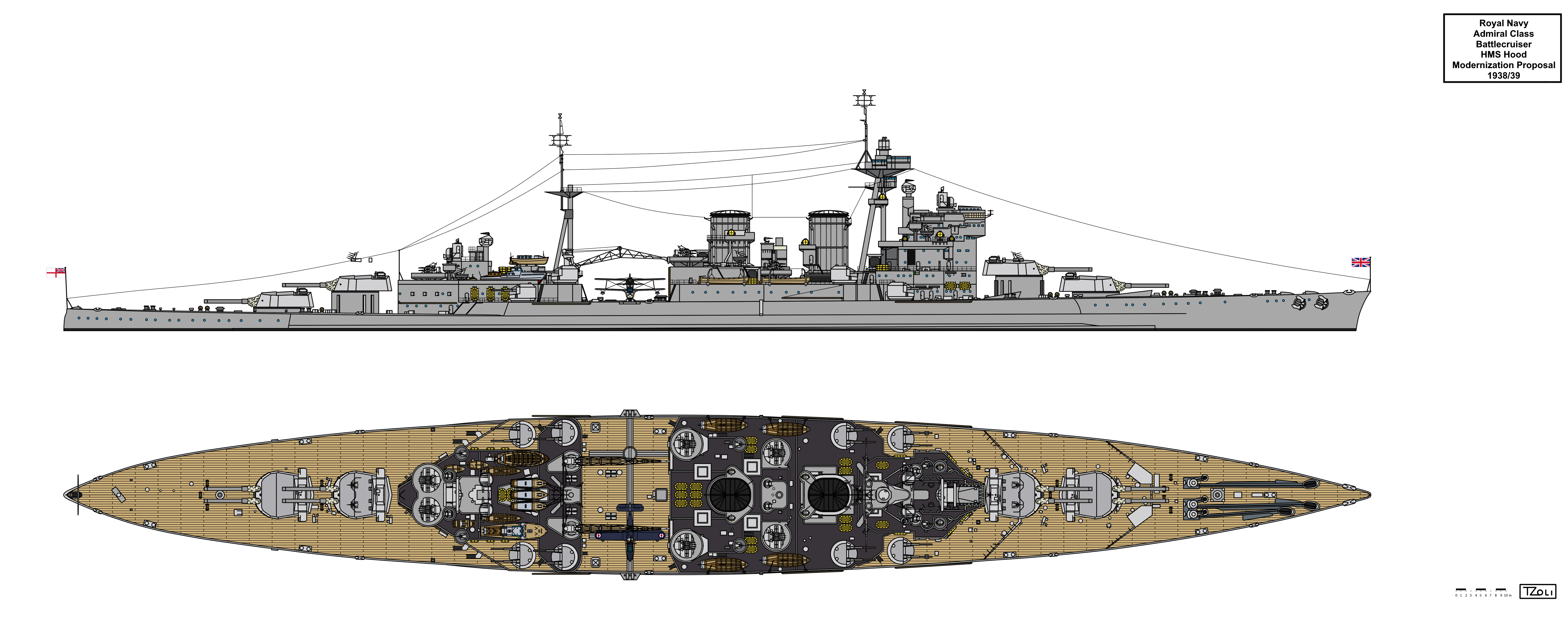
After the First and later the Second London Naval Treaties which forbid (First) the construction of new capital ships but allowed the modernizations and extensive refits of existing ones to improve their fighting capabilities of the signatory nations. For the RN this meant plans were drawn up to modernize their capital ship fleet, to be precise the Renown and Hood class Battlecruisers and the Queen Elizabeth and Nelson class Battleships. The Revenges were deemed for replacement by the newly designed and built King George Class Battleships while the Queen Elizabeths by the Lion class battleships hence the Revenges were never received their extensive refit and the QE's got different modernization proposals to test the new technologies. But there were 3 chokepoints for these rebuilds:
- The Naval Budget
- The capacities of the various shipyards
- The gun and turret manufacturing industry
The Royal Navy had to prioritise which classes and which ships were to be modernized first and they decided that the order was:
Valiant (1st phase)
Barham (1st phase)
Malaya (1st phase)
Warspite
Valiant
Queen Elizabeth
Renown
Repulse
Hood
Nelson
Rodney
But due to shipyard capacity and the war the last 3 (Hood, Nelson, Rodney) and the full modernisations of Barham and Malaya were not carried out still plans and proposals were made for these ships. Here I show you the KGV style modernization scheme for Hood which if were finished would made the ship well protected against both surface threats by improving her armour and both air threats by vastly increasing her AA armament. Her machinery too would had been replaced but it is not known by what kind. Refurbishment of the turbines? Replacement of the Boilers? Full machinery overhaul?
The design had the following characteristics:
Dimensions: 246,9 (pp) x 259,2 (wl) x 262,13 (oa) x 31,7 x 8,7 meters
Displacement: 46.000tons (standard)
Armour: 305mm belt at 10°incline, 76mm over Machinery, 102mm over Magazines deck, 102mm slopes.
Engines: Unknown, minimum 150-160.000shp Parsons Steam Turbines, 4 shafts
Range: 14.200km at 30km/h (7.600nm at 16knots)
Speed: 57km/h (30,75knots)
Armaments:
4x2 15"/42 (381mm/42) BL Mark I Cannons,
8x2 5,25"/50 (133mm/50) QF Mark I Guns,
6x8 40mm/39 QF Mark VIII Pom-Pom AA Guns,
6x4 12,7mm/62 MG Mark III AA Guns
Sensor suite:
2x Type 79 Air-search Radar on both of the masts
1x Type 273 Surface search Radar on the mainmast fighting top or "starfish" structure
1x Type 281 Air-warning Radar on top of the aft mast
6x Type 282 Fire-control Radar sets one for each Pom-Pom director
2x Type 284 Fire-control Radar on the main armament director/rangefinders
4x Type 285 Fire-control Radar sets one for each secondary armament director/rangefinder
2x Type 290 Air-warning Radar on top of the masts
Last edited:

